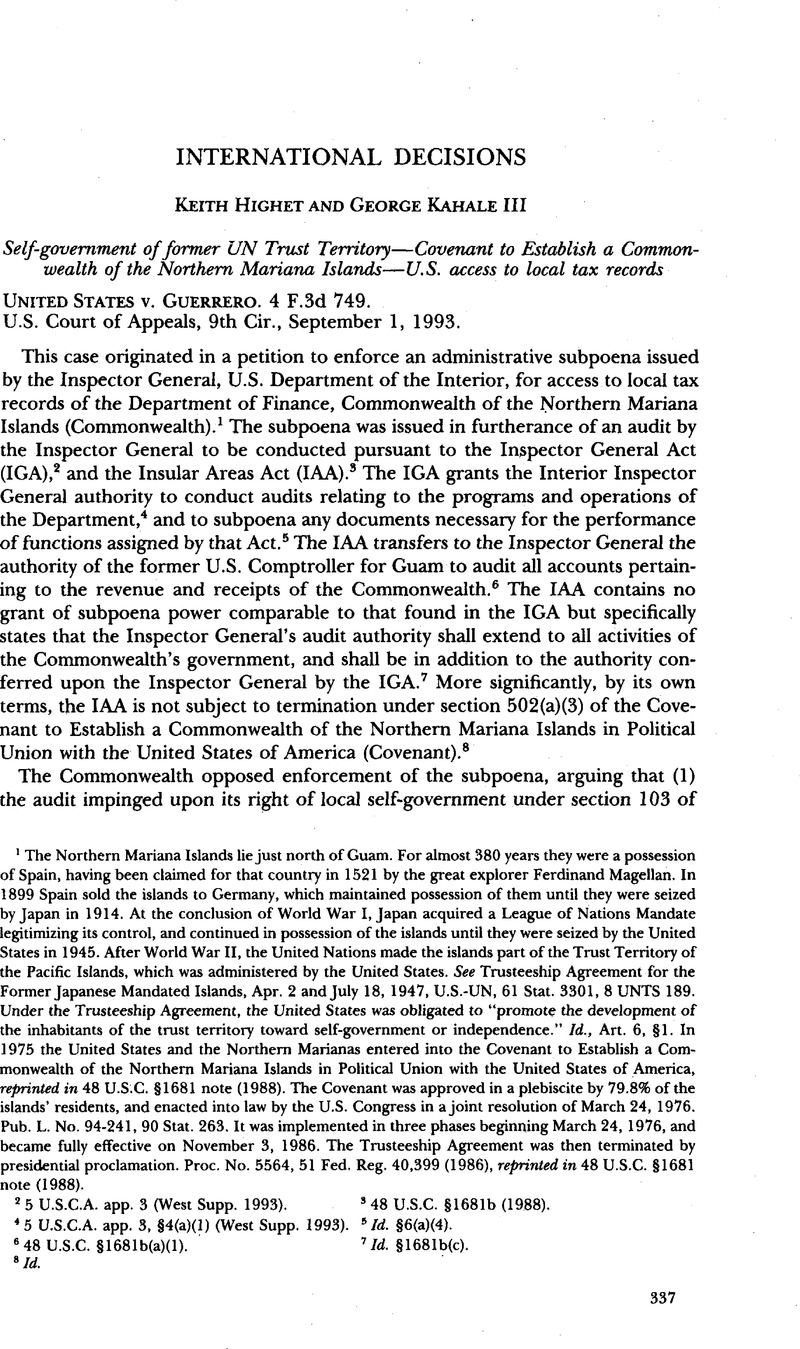No CrossRef data available.
Published online by Cambridge University Press: 27 February 2017

1 The Northern Mariana Islands lie just north of Guam. For almost 380 years they were a possession of Spain, having been claimed for that country in 1521 by the great explorer Ferdinand Magellan. In 1899 Spain sold the islands to Germany, which maintained possession of them until they were seized by Japan in 1914. At the conclusion of World War I, Japan acquired a League of Nations Mandate legitimizing its control, and continued in possession of the islands until they were seized by the United States in 1945. After World War II, the United Nations made the islands part of the Trust Territory of the Pacific Islands, which was administered by the United States. See Trusteeship Agreement for the Former Japanese Mandated Islands, Apr. 2 and July 18, 1947, U.S.-UN, 61 Stat. 3301, 8 UNTS 189. Under the Trusteeship Agreement, the United States was obligated to “promote the development of the inhabitants of the trust territory toward self-government or independence.” Id., Art. 6, §1. In 1975 the United States and the Northern Marianas entered into the Covenant to Establish a Commonwealth of the Northern Mariana Islands in Political Union with the United States of America, reprinted in 48 U.S.C. §1681 note (1988). The Covenant was approved in a plebiscite by 79.8% of the islands' residents, and enacted into law by the U.S. Congress in a joint resolution of March 24, 1976. Pub. L. No. 94-241, 90 Stat. 263, It was implemented in three phases beginning March 24, 1976, and became fully effective on November 3, 1986. The Trusteeship Agreement was then terminated by presidential proclamation. Proc. No. 5564, 51 Fed. Reg. 40,399 (1986), reprinted in 48 U.S.C. §1681 note (1988).
2 5 U.S.C.A. app. 3 (West Supp. 1993).
3 48 U.S.C. §1681b (1988).
4 5 U.S.C.A. app. S, §4(a)(1) (West Supp. 1993).
5 Id. §6(a)(4).
6 48 U.S.C. §1681b(a)(1).
7 Id. §1681b(c).
8 Id.
9 26 U.S.C. §6103 (1988).
10 4 F.3d 749, 753.
11 896 F.2d 426, 429 (9th Cir. 1990).
12 723 F.2d 682, 687 (9th Cir. 1984).
13 U.S. Const. Art. IV, §3, cl. 2.
14 4 F.3d at 754.
15 Id. at 755.
16 Id.
17 847 F.2d 108 (3d Cir. 1988), cert, denied, 488 U.S. 955 (1988).
18 No. 83-018 (D. Guam June 29, 1983).
19 No. 89-008, 1989 U.S. Dist. lexis 16,786 (D.N. Mar. I. Oct. 27, 1989), appeal dismissed as moot, No. 89-16,404 (9th Cir. 1991).
20 No. 90-0004 (D. Guam Mar. 8, 1990).
21 See Marianas Political Status Commission, Section-by-Section Analysis, in Hearing on H.J. Res. 549 Before the Subcomm. on Territorial and Insular Affairs of the House Comm. on Interior and Insular Affairs, 94th Cong., 1st Sess. 385, 663 (1975). According to the commission, the term “self-government” meant that the people would be able to “determine their own form of government” and “the manner in which they w[ould] govern themselves.” Id. at 628. The commission made no mention of any restraint on the substantive lawmaking authority of the United States.